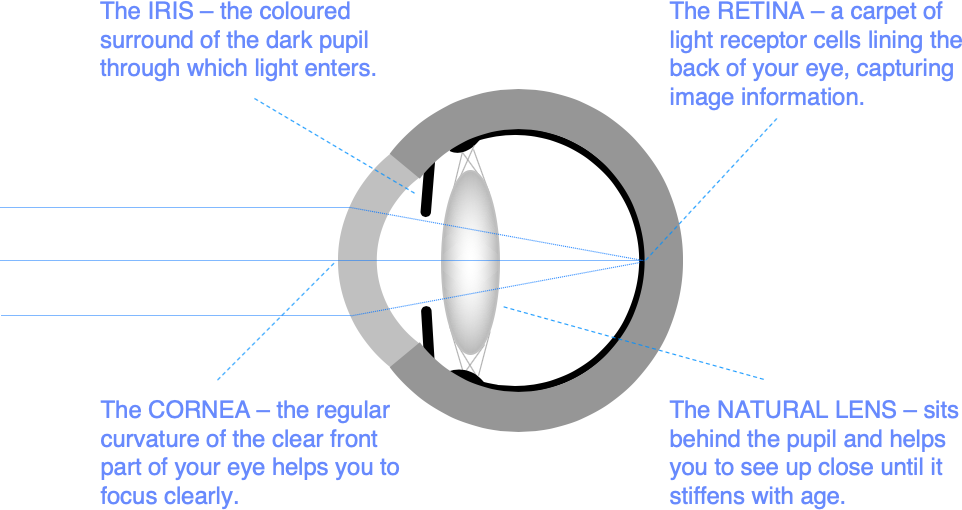You are here:
- Your Eyes / Reading Vision
Presbyopia (age-related loss of near vision)
People with good eyesight are able to form a clear image of a distant object on the retina without any help from glasses or contact lenses. When you are younger, the natural lens in the eye is flexible enough to allow you to automatically focus on near objects and see them clearly. But the natural lens stiffens with age.

For people with good eyesight, the ability to see up close starts to diminish from the mid-40s on. At around age 43-44, you find that you are slower to focus on near objects, reading in poor light becomes more difficult, and you have to hold things further away to see them clearly. This is a natural change affects everyone. People with good distance vision start to need reading glasses, and people who are already wearing glasses need a bifocal or varifocal prescription.
As you age, the loss of near vision becomes more pronounced. There are three important ranges of vision: distance (sport, outdoor activities, driving, television); intermediate vision (working with your hands, seeing computer screens); and near (reading). People typically find that they need glasses for both the near and intermediate range as they move into their 50s. If you are hyperopic, distance vision also deteriorates as your lens stiffens further and you lose the ability to compensate.
Flexibility of focus is mostly gone by your late 50s. Your eyesight should then stay pretty stable provided you are not developing any of the common age-related problems with the eye – cataract in particular.
Vision correction surgery
Many people get fed up with glasses and contact lenses as they enter the reading glasses age-group. Fortunately, there is now a range of good solutions for aging eyes that will help you to markedly improve or completely restore your near vision.
We will be able to give you clear advice about which procedure would suit you best after tests at your preliminary consultation.
Here are some of the options:
-
Laser vision correction – a common strategy is to use custom laser vision correction techniques that combine good intermediate vision in one eye and good distance in the other. Many contact lens wearers are already used to this approach. Input from the two eyes blends together in your one view of the world and works very effectively to extend your range of focus.
-
ICL implantation – newer ICL implants can be combined in a strategy similar to custom laser vision correction. This works well for people with higher spectacle prescriptions.
-
RLE (lens exchange) – modern trifocal intraocular lens implants correct distance, intermediate and near vision leaving most patients completely spectacle free.
You can find detailed information for each of these treatments on this site under Procedures.
Preparing for your consultation
If you are a soft contact lens wearer, you should leave your contact lenses out for 3 days before your consultation. Rigid contact lenses should be left out for 2 weeks. Contact lens wear can temporarily change the surface shape of your cornea. We ask you to leave your contact lenses out to help ensure that scan information we will use to guide your treatment is as accurate as possible.
You will normally be with us for 1-2 hours to allow time for scanning, refraction testing, eye health screening and procedure advice. There is usually some waiting between stages of the consultation, so bring something to read or to listen to.
We often dilate your pupils to help examine the back of your eye. This can make driving more difficult for several hours afterwards. Parking is restricted in central London. So, we would recommend travelling to us using public transport or taxi.
The nearest tube station is OLD STREET (Northern Line).
Appointments and Enquiries
If you wish to arrange a preliminary consultation, please telephone Angelique Thomas on 020 7566 2156 or 07484 081815 (or from outside the UK +44 20 7566 2156 or +44 7484 081815) or email moorfields.ballan@nhs.net
